
Thank you for helping me get the work to here!
Prof Scott is the BEST!
Digital Applications in Sculpture Computer Modeling for Sculpture Projects



 My brother and I had a good discussion about "Frenemies" the other night. A frenemy is a person who doesn't care about you enough to be your enemy, and yet doesn't think you're valuable enough to be your friend. Avoid frenemies at all costs. They are more detrimental to your health than any enemy could be. They are traitors and they are false.
My brother and I had a good discussion about "Frenemies" the other night. A frenemy is a person who doesn't care about you enough to be your enemy, and yet doesn't think you're valuable enough to be your friend. Avoid frenemies at all costs. They are more detrimental to your health than any enemy could be. They are traitors and they are false.
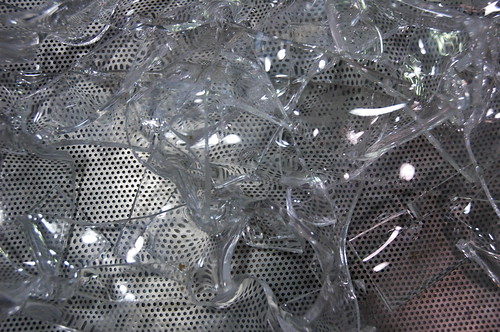
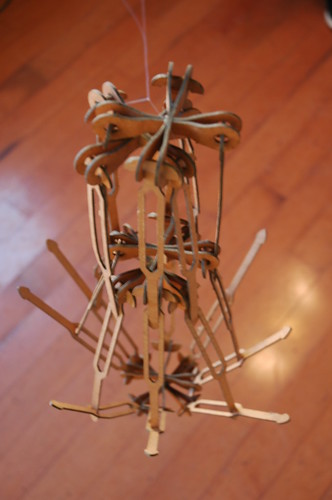
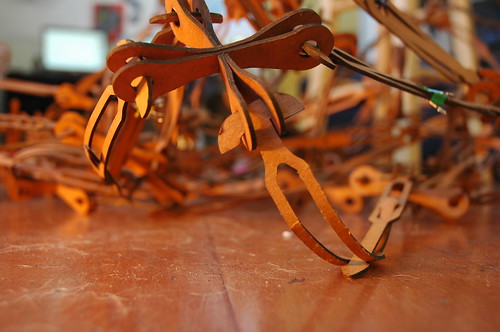

 Project three was an experiment with dividing a model into slices to easily construct them out of material. The first attempt with the "Dino" lamp(first above image) was a success. Constructing the second model was not a success, the pieces did not clearly represent the original digital model well. The third attempt at serial stacking the piece out of cardboard displayed the digital model successfully and added interest to the piece.
Project three was an experiment with dividing a model into slices to easily construct them out of material. The first attempt with the "Dino" lamp(first above image) was a success. Constructing the second model was not a success, the pieces did not clearly represent the original digital model well. The third attempt at serial stacking the piece out of cardboard displayed the digital model successfully and added interest to the piece.

 On the left is the massive unroll file which will help me create the sculpture on the right. I placed the image in Hyper-crack and made it look a little like the Batmobile. in a dark glass. I will be ready to cut this out of LOTS of cardboard and the finished work will measure about 20 X 30...
On the left is the massive unroll file which will help me create the sculpture on the right. I placed the image in Hyper-crack and made it look a little like the Batmobile. in a dark glass. I will be ready to cut this out of LOTS of cardboard and the finished work will measure about 20 X 30...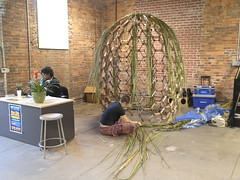
A collaborative Sculpture by John Adams (Industrial Design) an Ricki Dwyer (Fibers). This work combines digital fabrication and basket weaving techniques.These photos depict the work in progress which will be complete for finals in two days. This is an excellent example of both the collaborative and high-tech high touch ethos of the sculpture minor program.



 some level.
some level.
 Tonight, I plan to cast everybody with Smooth-Cast 300, and then hollow out mamma rat and turn her into a lamp. I plan to poxy the babies against the sides of her belly, so you can see their outlines within her when the lamp is lit. If this does not yield the result that I'm looking for, I plan to paint black dotted outlines inside of the lamp, as in Falynn's illustration. I'm also going to add felt ears to the final product. I wanted some part of her to be soft! This also will add to my plan to make her look somewhat scrappy; she is all knocked up after all.
Tonight, I plan to cast everybody with Smooth-Cast 300, and then hollow out mamma rat and turn her into a lamp. I plan to poxy the babies against the sides of her belly, so you can see their outlines within her when the lamp is lit. If this does not yield the result that I'm looking for, I plan to paint black dotted outlines inside of the lamp, as in Falynn's illustration. I'm also going to add felt ears to the final product. I wanted some part of her to be soft! This also will add to my plan to make her look somewhat scrappy; she is all knocked up after all. material over it several times. I then wanted to make a large piece of wall art out of my many pieces.
material over it several times. I then wanted to make a large piece of wall art out of my many pieces.

 out of acrylic).
out of acrylic). ently enc
ently enc asing your mold, or splitting it in half during the forming process. Plus, it's cheap! When I do this next, I'm going to order the material in bulk, and get each sheet for 69 cents instead of 99. It would be completely affordable to create a pattern that covered an entire wall - and I'm already thinking about fine art as well as commercial applications. I could sell this to parents who want a fun nursery for their child, but don't want the permanence of paint or a wall sticker, and who would also appreciate having soft cushy walls. This is safe and fun, and the tactile nature of the material is good for a developing brain. As for a fine artapplication, you'll have to follow my blog, wait, and see!
asing your mold, or splitting it in half during the forming process. Plus, it's cheap! When I do this next, I'm going to order the material in bulk, and get each sheet for 69 cents instead of 99. It would be completely affordable to create a pattern that covered an entire wall - and I'm already thinking about fine art as well as commercial applications. I could sell this to parents who want a fun nursery for their child, but don't want the permanence of paint or a wall sticker, and who would also appreciate having soft cushy walls. This is safe and fun, and the tactile nature of the material is good for a developing brain. As for a fine artapplication, you'll have to follow my blog, wait, and see!






 The profile image of the face was drawn using as a curve, in RHINO, rotated into a 360 degree vessel-like form. The Ribs holding the face image upright are cut from a secret script compliments of circles of friends of Prof. Scott. (Thanks for letting me carry on with lots of visual puns...)
The profile image of the face was drawn using as a curve, in RHINO, rotated into a 360 degree vessel-like form. The Ribs holding the face image upright are cut from a secret script compliments of circles of friends of Prof. Scott. (Thanks for letting me carry on with lots of visual puns...)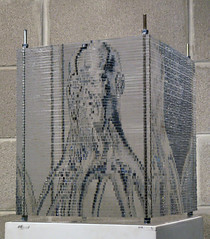
An extension of an earlier work "Soul On Ice". In this work the form of the BlackManGrove is encased within a cubic framework. The Object within is revealed through the interior contours. I love that the three dimensional form is revealed within based on the light and the viewers location from the piece. The refraction and reflections of the light reveals the modeling of the form.


 Another script was applied after the piece was finished that placed each piece side-by-side. The pieces were then arranged in a grid 18x32 (the length of the laser bed) and color coded for the laser printer.
Another script was applied after the piece was finished that placed each piece side-by-side. The pieces were then arranged in a grid 18x32 (the length of the laser bed) and color coded for the laser printer.

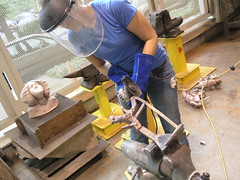
SCPT 250:
This course explores the relationship between digital tools and sculptural practice. Lectures and hands-on activities are supplemented by 2-D vector based programs, digital photography software and 3-D modeling programs. Students learn how to use the computer as a design tool for sculpture and to prepare files for various outputs.
SCPT 450:
Students explore their own personal visions using digital tools and computer software programs designed for the development of 3-D forms, spaces, objects, sites and processes. Students develop a critical basis for the evaluation of their use and explore the possibilities and implications of digital tools and processes.
Professor _ Andrew F. Scott
afscott@scad.edu